#ecology and evolutionary biology
Explore tagged Tumblr posts
Text
The modern world is nice, but sometimes you just get the urge to go primitive. Because I'm a complete wimp who would die within a day of giving up the internet, I'm going to deal with that urge by talking about primitive animals. It's Wet Beast Wednesday and I'm talking about lancelets.

(image: a lancelet. Not much to look at, are they?)
Lancelets, or amphioxi, are highly basal (close to the ancestral form) chordates that are vaguely similar to fish, but are vastly more primitive. They have all the characteristics of chordates, the key one being a notochord, a flexible rodlike structure that goes down the body. The majority of chordates that are still alive are vertebrates, who have incorporated the notochord into the spinal column. The other groups of surviving chordates are the tunicates (who I'll get to eventually) and the lancelets. Because lancelets are so primitive, they are used at model organisms representing an early stage of vertebrate evolution. It was originally thought that lancelets are remnants of an early lineage that eventually evolved into vertebrates. Genetic studies later showed that tunicates are actually more closely related to modern vertebrates than lancelets. They are still used as a model organism as they are a fantastic representation of early chordates. The similarity of lancelets to the 530 million year old Pikaia gracilens, one of the earliest known chordates, is one of the reasons they are such a useful model organism.

(image: a diagram of lancelet anatomy by Wikipedia user Systematicist)
Lancelets can be found all over the world, living in temperate to tropical shallow seas. The only known exception is Asymmetron inferum, which has been found around whale falls at 225 m (738 ft) deep. They are small animals, reaching around 8 cm at their largest. An amphioxus looks pretty worm-like, with a simple mouth at one end and a pointed tail at the other. The name amphioxus means "both (ends) pointed" which is a pretty appropriate description. The mouth is lined with tentacle-like threads called oral cilli, which are used for feeding. Lancelets are filter-feeders that use the cirri to filter plankton, microbes, and organic detritus. Water and food pass into the pharynx (back of the mouth), which is line with gill slits. This is where it gets weird. The gill slits aren't used for respiration, but for feeding. Mucus gets pushed through the gill slits by cilia, trapping the food and moving it deeper into the digestive tract. Not only to lancelets not use their gill slits to respirate, they actually don't have a respiratory system at all. Instead, they just absorb dissolved oxygen through their thin and simple layer of skin. Their circulatory system doesn't move oxygen around either as there is no heart or hemoglobin present. For what it's worth, they don't have a proper live either. When you look at a lancelet's anatomy, you can see similarities to fish anatomy, just much more primitive and with some parts missing.
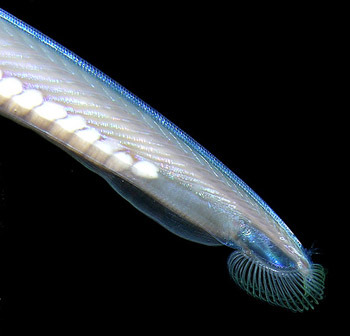
(image: the head of a lancelet, with mouth and cilli visible)
Lancelets have 4 different systems used for vision. Two, the Joseph cells and Hesse organs, are simple photoreceptors that are on the notochord and detect light along the back of the animal. Imagine having a bunch of very simple yes on your spinal cord that can see through your skin. There is also a simple photoreceptor called the lamellar body (which confusingly is also the name of a type of lipid) and a single simple eye on the head. Speaking of light, lancelets are florescent, producing green light when exposed to blue to ultraviolet light. In all species, the proteins responsible for this are found around the cilii and eye, but some species also have them in the gonads and tail. The purpose for this florescence isn't exactly known, but a common hypothesis is that it helps attract plankton toward their mouths.
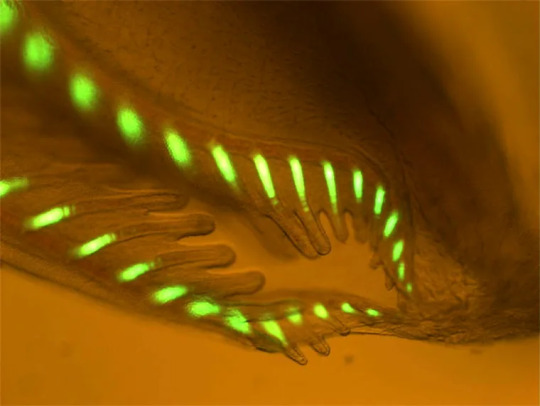
(image: an extreme close-up of a lancelet's cilli fluorescing)
Lancelets have seasonal reproduction cycles that occur in summer. Females release their eggs first, followed my males releasing sperm to fertilize them. Depending on species, spawning can either occur at specific times, or gradually throughout breeding season. Development occurs in several stages. In the frist stage, they live in the substrate, but they will quickly move into the water column to become swimmers. These swimming larvae practice diel vertical migration, traveling to the surface at night and returning to the seafloor in the day. While larvae can swim, they are still subject to the current and can be carried long distances. Adults retain their ability to swim, which is done by wriggling like an eel and in some cases, spinning around in a spiral fashion while moving forward. Unlike the larvae, adults spend most of their time buried in the substrate with only their heads exposed. They typically only emerge when mating or if disturbed.
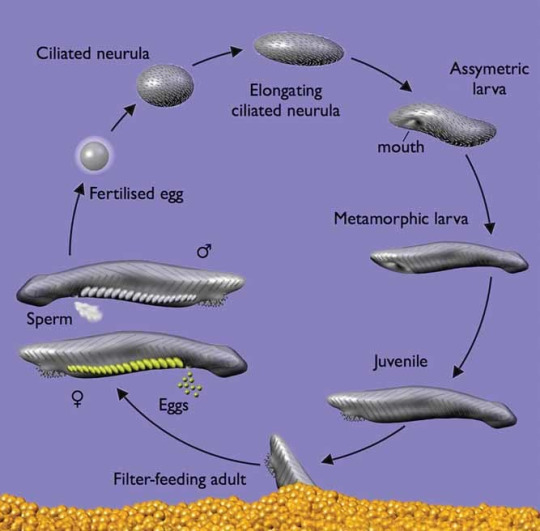
(image: a diagram of the lancelet life cycle. source)
Because of their use as model organisms, humans have developed methods to keep and breed lancelets in captivity. The majority of research has been done on Branchiostoma lanceolatum, but several other species have been studied. Multiple species are endangered due to pollution and global warming. Several species are edible and can either be eaten whole or used as a food additive. In spring, when their gonads begin to develop for breeding season, they develop a bad flavor.
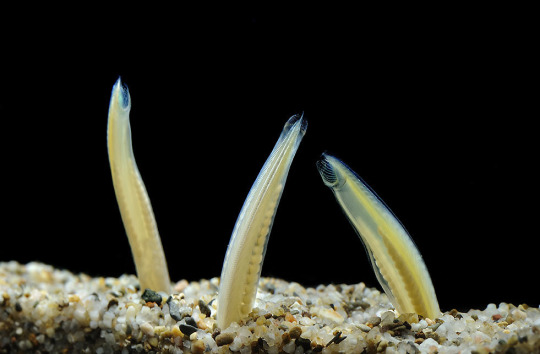
Mom: "we have garden eels at home". Garden eels at home:
(image: three lancelets sticking their heads out of the sediment)
#wet beast wednesday#weird-ass tube beast#lancelet#amphioxus#chordate#chordata#marine biology#biology#ecology#zoology#animal facts#evolutionary biology
249 notes
·
View notes
Text
I lowkey have a bachelors degree
29 notes
·
View notes
Text
the only valid french people are the french parasitologists because look what they named this recently discovered parasite:
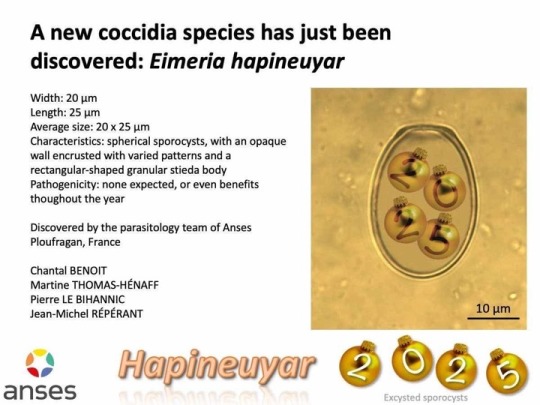
Hapi Neu Yar everyone
3 notes
·
View notes
Text

page 226 - You wanna see productive. Check this out. All class A, even after cleaning, no Bs, Cs or Ds in the bunch.
All my IVF peeps out there know what I'm talking about!!!
Imagine reporting an increased use of your servers for cloud computing on your company's quarterly results call and acting like it's something to be proud of. As if you had created value by destroying forests to harvest minerals, and heated the earth to cool your compute. Imagine living in a system that labels something productive while it is hastening own demise and that of everyone unfortunate enough to live within it, adjacent to it, or on the same planet as it.
I guess what I'm saying is I want to have a baby.
#biology#biologist#zoology#zoologist#text#textbook#fertilization in parascaris#parascaris#fertilization#fertilize#fertilizer#nitrogen#phosphate#sperm#egg#nucleus#chromosomes#evolution#modern evolutionary theory#destruction#ecological collapse#societal collapse#climate crisis#ivf#corporation#capitalism#corporation as ai
5 notes
·
View notes
Text
Looking for: evolutionary biologists / ecologists / wildlife biologists / etc.
This might be a stretch, but are there possibly any folks who attended college for ecology or evolutionary biology (or related subjects) that wouldn't mind chatting with me about their experiences? I'm incredibly conflicted about majoring in English or ecology/biology, and would love to talk to someone with experience in the science majors I'm interested in.
If you fit this description, please feel free to dm me directly or comment if I can dm you! <3
#biology#evolutionary biology#wildlife biology#stem#zoology#biologist#wildlife biologist#biodiversity#ecology#ecologist#entomology#genomics#evolution
5 notes
·
View notes
Text
Horseshoe crabs, Earth's ancient creatures, face endangerment due to excessive baiting, unintended capture, LAL testing, and shoreline development. Click to read more
#writerslife#biodiversity#women writers#writer things#articles#writerscommunity#blogger#horseshoe crab#sea creatures#marine life#aquatic life#marine biology#science#the more you know#evolutionary biology#biology#ecology#conservation#zoology#endangered species#ecosystem#tumblog#artists on tumblr#writers on tumblr#blogs#blogspot#blog stuff#blogging#dailyprompt#bloggers
2 notes
·
View notes
Text
this book has led me down a rabbit hole of searching whether birds can get rabies
#leigh reads the lost world#side note i wish i could study everything in the world ❤️#harding has barely even appeared so far but every time she and her work is mentioned im like hmm. pool girl meme but the pool is biology#i almost majored in bio w an ecology focus but then i looked into it more and realized the odds of me getting a good job w it esp without#grad school (which paying for was at the time unfathomable to me) were vv slim. but it calls to me sometimes#but at the same time we have arby doing all this compsci stuff and thorne and eddie w the various engineering disciplines. and malcolm w th#evolutionary studies. ACK#i love u stem…
3 notes
·
View notes
Text
not my job asking for my high school transcript
2 notes
·
View notes
Text
Selective pressure for the luckiest, most wish-granting dandelion
Dandelions have a symbiotic relationship with little kids who make wishes
96K notes
·
View notes
Text
Happy Evolution Day, everyone!
Today marks the anniversary of The Origin of Species' publication.
We have hard days ahead of us, but I'd like to think we can learn from nature. On how to adapt and overcome hardship and struggle, to continue ever onward.
#Evolution Day#charles darwin#Evolution#Biology#Ecobiology#The Origin of Species#Evolutionary biology#Political post#Err political and scientific post#ecosocialism#Integrating ecology with politics. My bread and butter.
1 note
·
View note
Text
This is my first job where I have a living wage (not survivable, living!!!) and, setting aside my feelings of it not being in my field / something I’m super passionate about, I’m quite content!
That being said (and this isn’t a real complaint), part of me is miffed because this is the original field I went to school for but switched within 6 months and got in a huge argument with my parents about. Like I love them and know they’re happy for me, but also I knowwww my mom has made some sort of smug comment to other family members about me being back in medical research “where I always should have been”
#I switched from cell and molecular biology to ecology and evolutionary biology#and it turned into a whoooole thing where it became clear just how bullshit their “we support your choices as long as you’re happy” lie was#it was also right after I accidentally outed myself#so when I say tensions were high I mean Godzilla giving King Kong a piggy back ride could’ve limboed under those tensions easy peasy#my previous job was just taking care of lab animals#and I know she was telling fam that I was helping with cancer and cystic fibrosis research#which is technically true. but I know she was making it sound like I did the research (I did not)#so now she can honestly say I’m doing glaucoma and Alzheimer’s research and I know she’s primping herself like a peacock during mating szn
0 notes
Text
The first is biology,* which tells us what humans truly are: clever chimps.
*Academic biology is a vast field; I draw on its ecological/evolutionary end rather than its molecular/cellular end.
"Why the West Rules – For Now: The patterns of history and what they reveal about the future" - Ian Morris
#book quotes#why the west rules – for now#ian morris#nonfiction#biology#chimps#academia#ecology#evolutionary biology#molecular biology#cellular biology
0 notes
Text
"acoustical consciousness". I coin that, it may have been minted by someone previously, but a fresh pressing and it refers in this case to the broad understanding of the way species use sound, in particular the well known and modulated sounds made by their own bodies in motion, to ascertain the nature of their surroundings and navigate and communicate. (Placing limits here, but secondary and tertiary consequences as cause and incentive and evolutionary feedback implied and included)
0 notes
Text
I'm curious if the misconception of what "survival of the fittest" means contributes to this. The term was originated by social Darwinist (read: eugenicist) Herbert Spencer but was later incorporated into Darwin's writings as an alternative to the term "natural selection."
What we mean when we use this phrase is not "only the strong survive by any means necessary," but "the individuals that are most suited (fit) to their environment will be able to pass on their genes."
The passing on of an individual's genetics is essentially what we consider fitness in today's understanding of evolutionary biology.
All this to say, the living world (communities, ecosystems, on up) is portrayed with this vicious "kill or be killed" lens. When, in actuality it's not! So much of our lives is dependent on mutually beneficial interactions like plant-pollinator interactions, or that of mycorrhizae and plant roots, or even the microorganisms that live on and inside your body!
Our world is amazing and beautiful and it's not at all the cruel way it's been framed.
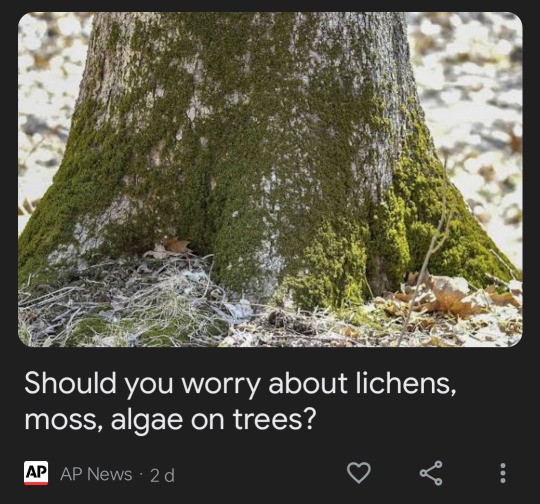
You guys . . . No. If the only thing I ever teach you is that lichens, moss, and algae are not hurting trees, then this entire endeavor will have been worth it. Who out there is looking at a fucking tree, seeing something growing on it, and stewing over it? I am imagining some man noticing a tree trunk for the first time in his godforsaken life and thinking "hmmm . . . That can't be right." Like not looking at a single other tree trunk, just worriedly turning it over in his head. Lying in bed, trying to fall asleep, can't stop thinking about that weird fuzzy stuff they saw on a tree earlier. Then he googles and sees this and can finally relax. The world is right again. Maybe next time he is out he looks at another tree and *gasp* there it is again! And suddenly it's everywhere: moss in the cracks of the sidewalk, lichen on the telephone poles, a slime of green algae on the subway wall. Suddenly the world is alive, and he no longer has to worry.
#aquila talks#ecology#evolutionary biology#at my heart im an organismal biologist but by training im an ecologist and dammit the living world is immensely and infinitely beautiful
10K notes
·
View notes
Note
It seems like there were a lot of saber toothed predators back in the day, why are there none now (apart from clouded leopards?)
that’s a good question! unfortunately “why” questions are very difficult to answer in paleontology; we just can’t definitively prove any of our hypotheses without observing the animals alive.
that being said, it’s a common trend in evolutionary biology that hyperspecialization tends to make an animal more vulnerable to extinction. things like saber teeth are really really good at one thing: killing very large prey quickly after immobilizing it. if that strategy is no longer viable, then the sabertooth doesn’t have any other plan to fall back on!
generalists, or jack-of-all-trades animals (think cougars and coyotes and black bears), tend to fare better when the environment shifts drastically. even if their preferred food source disappears, no worries! it’s not their only food source, because the generalist can do anything!
however, it’s entirely possible that saber teeth are actually a great evolutionary trait, and all the sabertooths just happened to go extinct for unrelated reasons. if that’s the case, then we just need to wait around until they re-evolve again in an extant group, since there are no living sabertooth lineages to work off of. we can only hope and dream :)
#it’s important to remember that right now we are literally just coming off a mass extinction#our world as we know it is painfully empty compared to times of high diversity#so to compre our current ecological condition to that of the middle pleistocene or even further back is a bit unfair#it could be that we have no sabertooths now because we dont have much of ANYTHING right now#only SIX species in TWO genera exist in the big cat subfamily. that’s critically low#but to be fair. pantherinae is also very young evolutionarily speaking#sabertooth cats (machairodontinae) had been around for a VERY long time#which could be what allowed them to develop such specialized teeth#maybe our cats just havent had enough time to grow their sabers yet#evolutionary biology#paleoblr
1 note
·
View note
Text
everyone manifest i get to go to puerto rico this summer for an internship 🙏
#chit chat#tropical forest ecology and biodiversity my beloved#PLEAASEEEEE i’m begging i will cry if i don’t get in actually i will not be fine for months i think#i also applied for another internship with yale/brown for ecology and evolutionary biology which like. ok great nice if i got in that would#be so amazing#but i want to go to puerto rico so badddd like#let me study freshwater fishies please 😭
1 note
·
View note